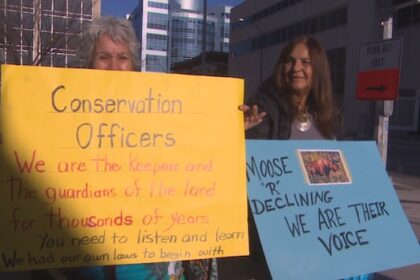OttawaPrime Minister Mark Carney’s first budget seeks to slash the public service by 16,000 full-time equivalent positions, or about 4.5 per cent of the workforce, over three years. Cuts to begin next year as part of Liberals’ goal to reduce workforce to ‘sustainable levels’Listen to this articleEstimated 6 minutesThe Canada Flag flies on the Peace Tower of Parliament Hill as pedestrians make their way along Sparks Street Mall in Ottawa on Tuesday, Nov. 9, 2021. A union representing over 120,000 federal public servants voted in favour of a countrywide strike mandate and they’ve been clear that wages are top of mind. (Sean Kilpatrick/CP)The federal budget announced Tuesday is set to slash 16,000 positions, or about 4.5 per cent of the public service workforce, over the next three fiscal years to return the size of the bureaucracy to a “more sustainable level.” That target is “relatively modest,” according to one expert, even as federal public sector unions prepared for deep cuts.The reductions are expected to begin in April 2026 and continue until 2029, according to the budget.The government says the public service has grown at a rate “far greater” than the Canadian population, peaking in 2024 at just under 370,000 employees. “We need to bring back the civil service to a more sustainable level,” said Finance Minister François-Philippe Champagne earlier Tuesday. “But we’re going to be very compassionate.”As of March this year, there were 357,965 public servants across Canada, 43 per cent of them in the National Capital Region. The federal government is the Ottawa-Gatineau region’s largest employer. Of the 16,000 full-time equivalents, 650 cut will be executive positions, which is about seven per cent of executive staff, according to budget documents.The cuts starting next year are part of the government’s larger goal of reducing the workforce to about 330,000 public servants by March 2029 — about 40,000 fewer than the all-time high in March 2024, according to the budget. In contrast, last year’s budget promised to cut 5,000 public service jobs over a handful of years. Members of the Public Service Alliance of Canada (PSAC) walk in the rain on a picket line outside during a strike in 2023. (Justin Tang/CP)These savings through restructuring the workforce are part of the government’s plan, among other measures, to “rein in” spending and generate about $60 billion in savings and revenues over five years.It will help offset Prime Minister Mark Carney’s first “spend less and invest more” budget, with a deficit of roughly $78 billion.Public service unions brace for cuts in federal budgetPart of comprehensive reviewEarlier this summer, the Carney government signalled there were cuts coming to the bureaucracy, tasking cabinet ministers to find up to 15 per cent in savings over the next three years after spending ballooned under the Trudeau government.The budget’s public service cuts are part of the details coming out of that comprehensive expenditure review that Ottawa launched in July. “The government understands transitions can be difficult and is committed to minimizing hardship for federal employees,” the budget document states. The budget hopes to reduce the impact of these reductions “to the greatest extent possible” through attrition and voluntary departures, proposing to offer a voluntary “early retirement incentive” program through its pension plan slated to start Jan. 15, 2026 and concluding within a year. That program is estimated to have a net fiscal impact of $1.5 billion over five years, starting this year.“So I think that people will be reassured in a way that we have made the right choices, and we’re going to do that in a smart and compassionate way preserving the key services that are dear to Canadians,” Champagne told reporters.WATCH | PSAC president criticizes public service cuts in federal budget:PSAC president criticizes public service cuts in federal budgetCanada’s proposed budget would cut the number of civil servants to 330,000 by 2028-29, a decline of about 40,000 positions or 10 per cent over five years. Sharon DeSousa, national president of the Public Service Alliance of Canada, called the cuts ‘drastic’ and said there should have been more consultation.In the coming weeks, departments are expected to communicate specific measures to staff and unions, the budget document states.“The federal government will continue to identify more efficiencies and potential savings,” it says, adding those will be shared in the next fiscal year’s departmental plans and estimates.“This still strikes me as relatively modest in terms of where they could have gone, in terms of getting the public service back to a pre-pandemic size,” said Sahir Khan, vice-president of the University of Ottawa’s Institute of Fiscal Studies and Democracy, who reviewed the budget documents Tuesday.However, he noted that the budget didn’t detail who’s getting cut from which department.’We need to bring back the civil service to a more sustainable level,’ said Finance Minister François-Philippe Champagne earlier Tuesday. (Spencer Colby/CP)“What we don’t have is a lot of detail,” he said. “They need to know, will the department be able to carry out its mission with the people? If you don’t know who’s getting cut, which programs are getting cut, how do you know what the results are going to be for the department?” The reductions reflect normal attrition through retirements, other departures and “further action the government is taking to slow spending.” This is already underway, with the bureaucracy reduced by about 10,000 employees from 2024 to 2025. Federal public service shrinks for 1st time in a decadeUnclear how cuts will be distributedThe savings proposed across departments and programs vary, but it’s unclear in budget documents how the public service job cuts will be distributed among departments.The government says it will focus on improving productivity and efficiency in the public sector, with a huge emphasis on modernizing government operations. A repeated theme to achieve savings among various departments is to simplify processes, reduce duplication, and use automation and artificial intelligence to increase productivity.Department of Justice, Shared Services Canada, Transport Canada and Public Services and Procurement Canada are among some departments to start implementing AI in various ways in workflows.Some other examples of departmental savings include Statistics Canada reducing the frequency of data collection and level of details, and Global Affairs reducing its international development funding and reducing mission expenses by consolidating embassies to fewer buildings. Immigration, Refugees and Citizenship Canada is also making “targeted adjustments” to programs such as the Interim Housing Assistance Program (IHAP), which helps provinces, municipalities and non-profits to support and house asylum claimants. Khan thinks for the public servants who will continue working, “much will be demanded of them.”“We’ve seen the public confidence drop in our public service over the years, and I think this is an ambitious budget. So that means that the ambition for leadership in the public service is going to be paramount,” he said. “Speed and quality of execution will now be the focus points for public servants.”ABOUT THE AUTHORPriscilla Ki Sun Hwang is a reporter with CBC News based in Ottawa. She’s worked with the investigative unit, CBC Toronto, and CBC North in Yellowknife, Whitehorse and Iqaluit. She has a Master of Journalism from Carleton University. Want to contact her? Email priscilla.hwang@cbc.ca
Monday, 22 Dec 2025
Canada – The Illusion
Search
Have an existing account?
Sign In
© 2022 Foxiz News Network. Ruby Design Company. All Rights Reserved.
You May also Like
- More News:
- history
- Standing Bear Network
- John Gonzalez
- ᐊᔭᐦᑊ ayahp — It happened
- Creation
- Beneath the Water
- Olympic gold medal
- Jim Thorpe
- type O blood
- the bringer of life
- Raven
- Wás’agi
- NoiseCat
- 'Sugarcane'
- The rivers still sing
- ᑲᓂᐸᐏᐟ ᒪᐢᑿ
- ᐅᑳᐤ okâw — We remember
- ᐊᓂᓈᐯᐃᐧᐣ aninâpêwin — Truth
- This is what it means to be human.
- Nokoma











